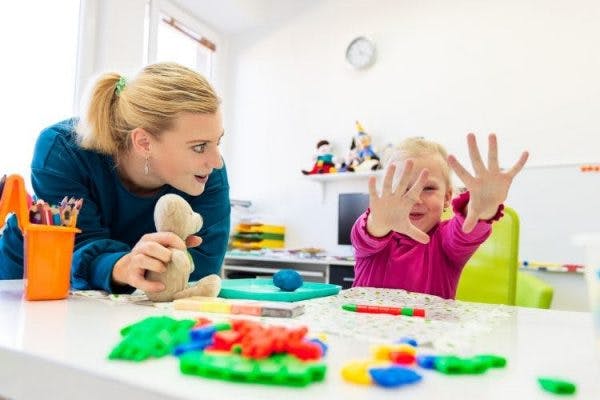Speech therapy can help individuals with cerebral palsy improve a variety of functions that require their oral motor muscles such as chewing, swallowing, speaking, and breathing.
This study of 1357 children with cerebral palsy found that approximately 36% of individuals experienced motor-based speech impairments while 42% have some sort of communication difficulty.
To help you understand how speech therapy addresses oral motor impairments in individuals with cerebral palsy, this article will discuss the goals and techniques used in speech therapy sessions.
How Cerebral Palsy Affects Speech
Just because an individual has cerebral palsy does not mean that they will need speech therapy. Cerebral palsy can affect motor control throughout the entire body. For some, it may only affect the legs, one side of the body, or a single limb.
When cerebral palsy affects the muscles around the mouth, individuals may struggle with functions like chewing, speaking, breathing, and swallowing.
Dysarthria is the most common motor speech disorder in people with cerebral palsy. Individuals with dysarthria have difficulty controlling the muscles in the mouth and generating enough breath to speak.
As a result, they may experience:
- Jumbled speech
- Poor pronunciation
- Inconsistent intonation
- Stuttering
- Feeding difficulties
- Nasally voice
These speech and feeding complications may significantly affect quality of life, increasing one’s risk of malnutrition, high levels of stress, and communication difficulties. To strengthen the oral motor muscles and improve communication and feeding skills, speech therapy is essential.
Goals of Speech Therapy for Cerebral Palsy
The primary goal of speech therapy is to improve one’s communication skills. To do this, a speech-language pathologist will utilize neuroplasticity.
Neuroplasticity is the central nervous system’s ability to make adaptive changes and reorganize itself based on one’s behaviors. As with all skills, the key to improvement is practice. Consistent practice helps stimulate the brain and reinforces demand for the task or movement performed.
At speech therapy, a speech-language pathologist will assess the individual’s communication and feeding skills and develop a personalized program that will help develop better control of their oral motor muscles. Additionally, a speech-language pathologist will make sure that your child is challenged the right amount to keep them engaged and motivated.
In the following section, we’ll discuss the benefits of speech therapy for individuals with oral motor impairments.
Benefits of Speech Therapy for Individuals with Cerebral Palsy

Cerebral palsy encompasses a wide range of motor impairments at varying severities. Because everyone experiences cerebral palsy uniquely, individuals will benefit most from a personalized treatment plan.
Those with milder cases of speech impairment may focus on enhancing natural speech and language while treatment for individuals with more severe cases may involve learning how to use alternative forms of communication such as synthetic speech devices, gestures, or writing.
Speech therapy can help individuals with cerebral palsy improve:
- Speech production
- Chewing and swallowing
- Listening & comprehension
- Breathing
- Use of augmentative or alternative communication systems
- Expressive language
- Voice
Additionally, learning how to effectively communicate with others may help boost your child’s confidence. In turn, they may begin to contribute more to conversations, develop better relationships with friends and family, and participate more in social settings. This can significantly improve their quality of life.
Speech therapists are also able to address some cognitive skills, such as joint attention and following directions. Although the brain damage from cerebral palsy does not directly cause cognitive deficits, some children with CP, especially in more severe cases, may have cognitive impairments that speech therapy could address.
Now that you understand the benefits of speech therapy for individuals with cerebral palsy, let’s go over a few commonly used techniques.
Speech Therapy Exercises for Individuals with Cerebral Palsy
To get a better idea of what to expect at a speech therapy session, this section will share some examples of exercises that may be recommended by a speech-language pathologist.
1. Bite Block Training
Bite blocks are small blocks that you place between your upper and lower teeth to keep your mouth open.
They stabilize your jaw so that you can practice moving your tongue and lips. For example, a speech-language pathologist may ask you to purse your lips together or move your tongue to the side.
Over time, the challenges will get more complex. You’ll gradually add sound to your tongue or lip movements and then practice without the bite block.
For children, the speech therapist may try to make these exercises more fun by having the child imitate an image of an animal’s facial expression to encourage different tongue and lip motions.
2. Vocal Conditioning
Vocal conditioning involves breaking up words into syllables and repeating specific sounds over and over.
For example, if the word is ‘candy’, you will break it up into 2 syllables: ‘can’ + ‘dy’.
Repeat each syllable 20 times. Then try putting them together and repeating the entire word 20 times.
3. Mirror Exercises
Children with cerebral palsy may not understand how to coordinate their mouth movements, which will prevent them from producing the right sounds.
Have your child watch your mouth as you make a sound or say a word. Then, have them try to repeat the sounds while looking in a mirror.
Practicing in front of a mirror may help your child see how different movements of the mouth affect sound.
Speech Therapy for Cerebral Palsy: Key Points
Speech therapy can help individuals with cerebral palsy overcome oral motor impairments and become effective communicators. By consistently practicing activities and exercises that engage the oral motor muscles, individuals promote adaptive changes in the brain.
We hope this article helped you understand the role of speech therapy in the management of cerebral palsy.











